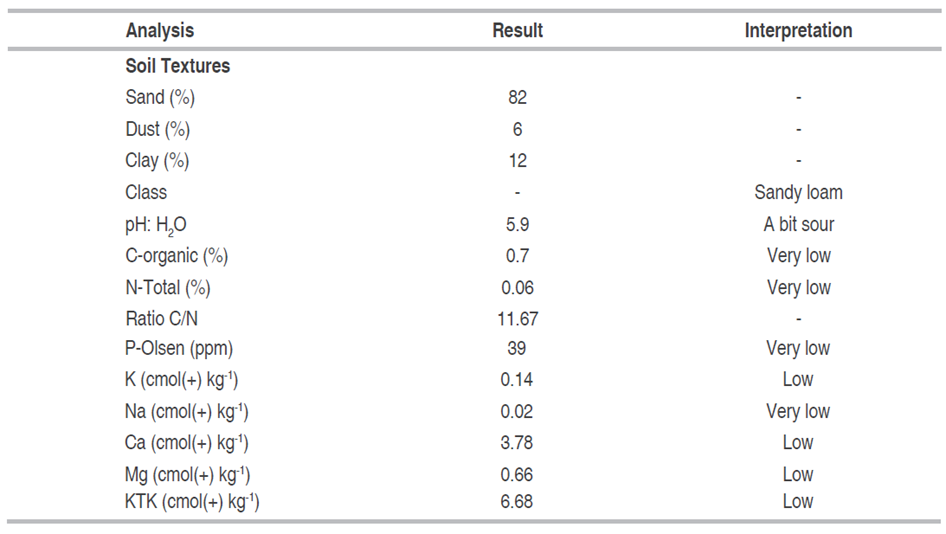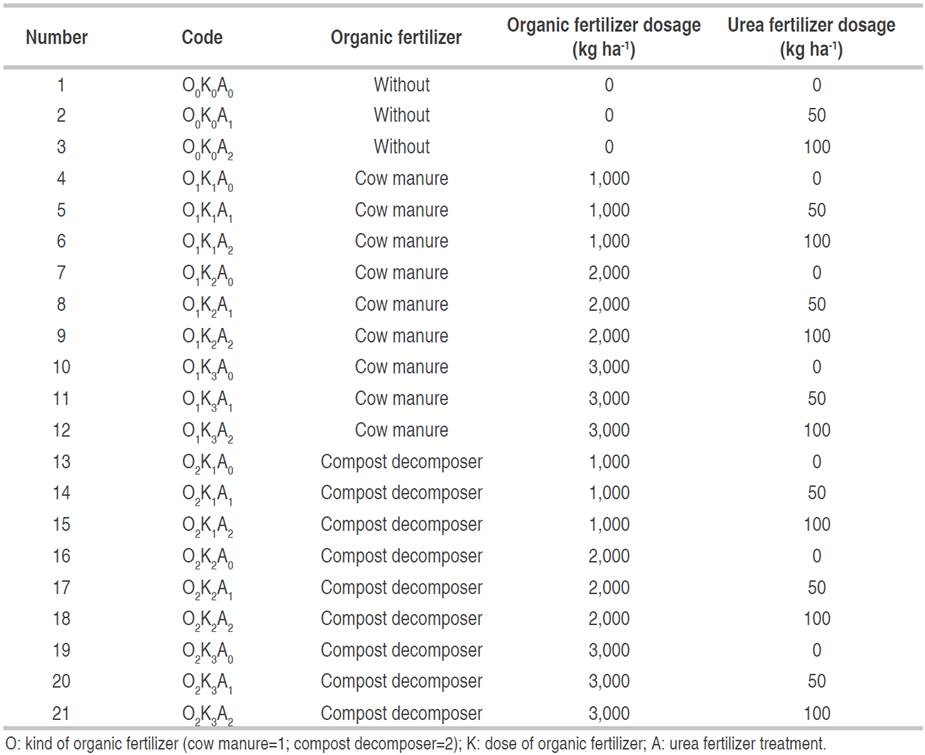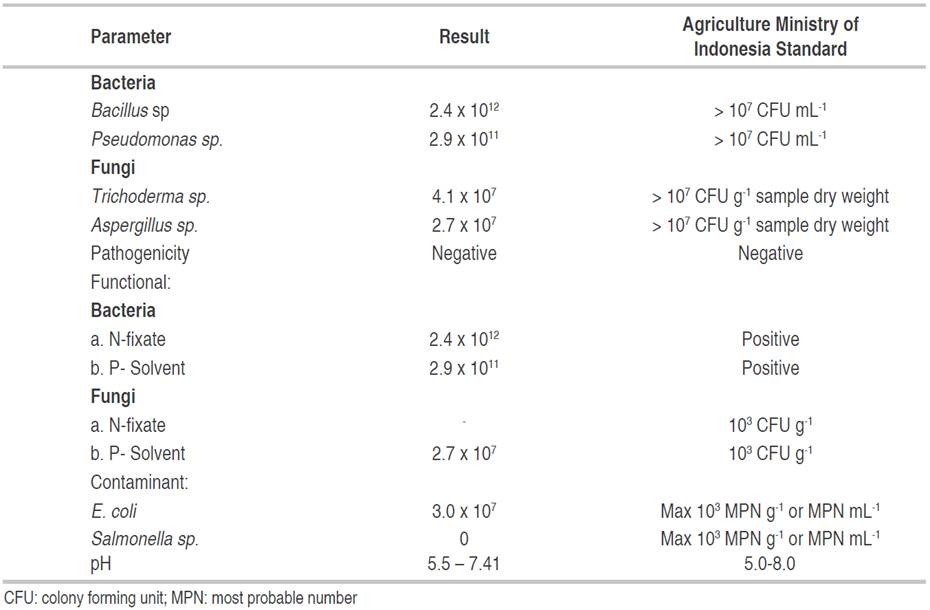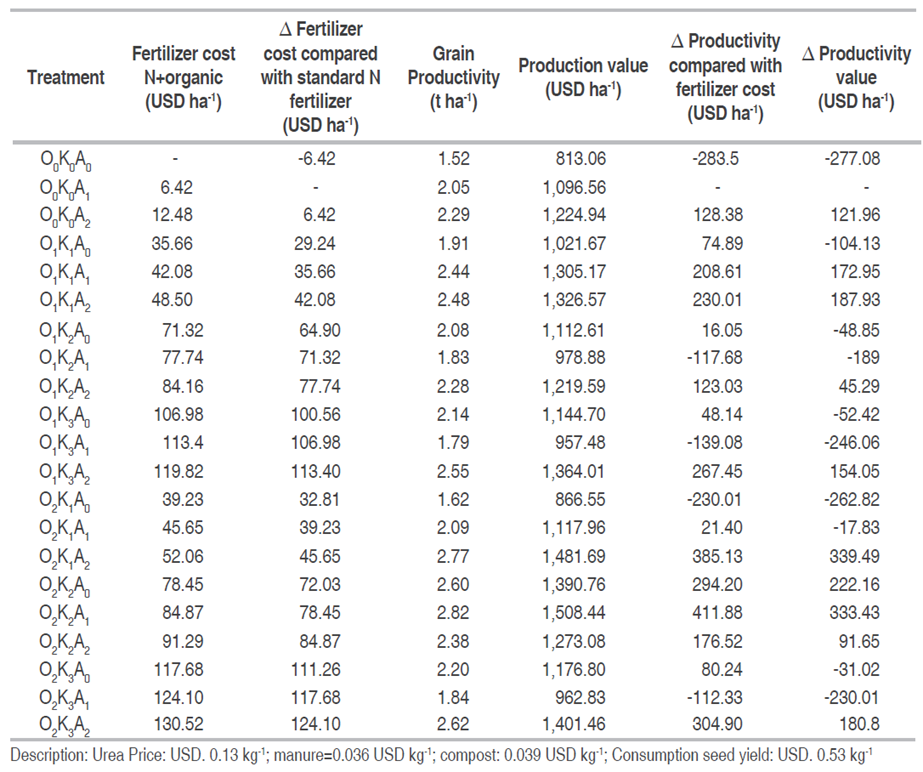Soybean (Glycine max (L.)) is one of the agricultural commodities with important value to humans. Soybean is known for its high protein content, making this commodity widely utilized as a main food source for humans and husbandry as well as oil producer (Capriotti et al., 2014; Pagano and Miransari, 2016). In order to optimize its growth, fertilization plays an important role to improve soybean productivity, especially in marginal soils. Chemical fertilizers can affect the microflora of the soil by modifying the chemical composition and physical character of the soil (Cwalina-Ambroziak and Bowszys, 2009; Klein et al., 2011; Wei et al., 2014; Wei et al., 2012). Naturally, the need of nitrogen (N)for legumes such as soybean has been partially met through the symbiosis of Rhizobium bacteria and root nodule, which absorbs nitrogen from the air. However, farmers tend to add chemical fertilizer excessively during soybean cultivation based on assumption that it may increase the yield (Abbasi et al., 2010). On the other hand, soybean can only absorb 35 to 70% of the entire nitrogen fertilizer applied. It means that chemical fertilizer would leave residues and contaminate the soil, deteriorating the soil quality. Therefore, organic fertilizer should be used to improve land productivity (Masaka et al., 2014), since this kind of fertilizer could be a better choice to mitigate the negative effects of chemical fertilizers by slowing soil degradation. According to some studies, organic fertilizers have a significant impact on soil nutrient availability, aggregate formation, and soil bacterial communities (Chai et al., 2019; Qaswar et al., 2020; Ye et al., 2019). Several researchers found that a high amount of chemical fertilizer would decrease root nodule formation and N-fixation from the air (Hinson, 1975; Saito et al., 2014; Dong et al., 2016). Furthermore, an overuse application of chemical fertilizers leads to a loss of soil fertility, bacterial diversity (Dinesh et al., 2010) and soil structure (Melero et al., 2011).
Several papers showed that treatments using organic fertilizer could solve this problem. Organic fertilizers play significant roles by fulfilling plants nutritional needs as well as improve the physical, chemical and biological properties in the soil. Organic fertilizers have a variety of beneficial effects on crop management, as they can be used as a source of various macro- and micro-nutrients for plants (Ahmad et al., 2019, Khan et al., 2020, Wajid et al., 2020). Organic substances might undergo decomposition by itself, it was considered to be a relatively slow process; therefore, human intervention was needed by adding compost decomposer. After such intervention, decomposition process would run faster and producing a better compost quality. In this context, this study aimed to evaluate the effectiveness of organic fertilizer treatment to reduce the amount of urea as chemical fertilizer needed in soybean cultivation.
MATERIALS AND METHODS
The research was conducted in wet season of 2018 in Bunbarat Village, Rubaru District, Sumenep Regency of Indonesia. Soil condition was relatively infertile; it was sandy in texture and contain C-organic matters. Content of P2O5 and K in the soil was very low (Table 1).
Organic fertilizer was made from cow manure with liquid decomposer, urea, SP-36, and KCl. Using a complete randomized design, combination of 21 treatments were repeated 3 times with 4x3 m plot size. Analysis of variance was carried out to compare the means of measurement data and then a Duncan Real Difference Test (DMRT 5%) was performed (Gomez and Gomez, 1984). Organic and chemical fertilizer combination of the 21 treatments is described in Table 2.
Cow manure and compost decomposer used in this research were made from cow dung. An application of additional decomposer was done to produce the compost decomposer which is not applied on cow manure fertilizer. This decomposer contains many kinds of fungi and bacteria which are important to accelerate the decomposition process (Table 3).
Argomulyo soybean [(Glycine max (L) Merr var. Argomulyo] was cultivated with a distance of 40x15 cm, 2 grains per hole. Organic fertilizer was added during tillage while urea (according to treatment), SP-36 and KCl were provided after 7-10 dap (days after planting). Soil nutrients, plant height, number of branches, number of nodes, number of pods and seeds per plant, number of active root nodules, number of inactive root nodules, dry weight of roots (oven), weight of 100 grains and yield (kg ha-1), also, financial analysis of soybean were quantitative parameters analyzed in a pre-experimental phase. Observations on these parameters and weight of dry roots were carried out using destructive method for plants at 60 dap. Active root nodule observations were recorded if the inner slice of the root nodule was dark red, while inactive root nodule was white to reddish white in color, which means that the soybeans have generated a symbiosis with Rhizobium by forming the root nodules.
RESULTS AND DISCUSSION
Soybean growth and yield
The growth of soybean was influenced by its genetic factors and environment. A mixture of chemical and organic fertilizer has a significant result on the plant height, number of branches, number of nodes, number of active and inactive root nodules and dry weight of roots and root nodules. Plant height and number of branches between 30 and 60 dap showed a noticeable difference according to the fertilization treatment, while differences in the number of plant nodes only was noticeable at 30 dap (Table 4).
Table 4 Effect of organic fertilizer on plant height, number of branches and soybean nodes in Rubaru District, Sumenep Regency, wet season 2018.
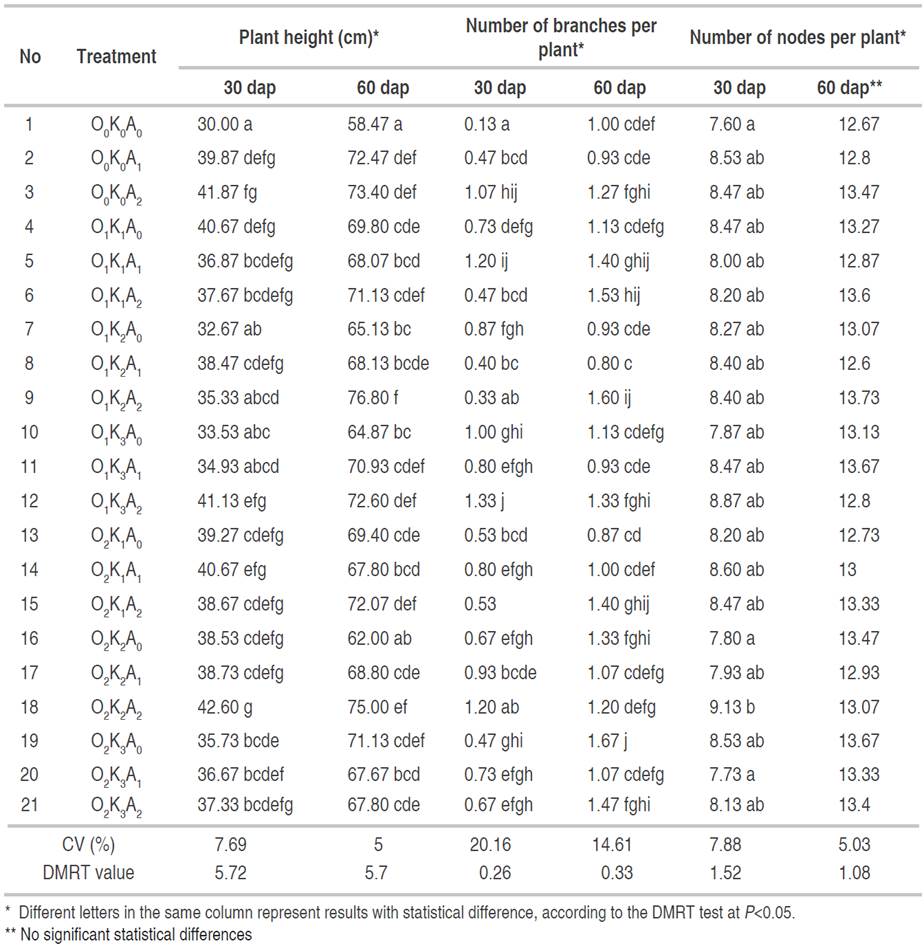
Treatment (O2K2A2) using 2,000 kg ha-1 compost with urea 100 kg ha-1 and treatment (O1K2A2) using 2,000 kg ha-1 cow manure with 100 kg ha-1 urea at 30 and 60 dap showed the highest plant height for each period, respectively. Meanwhile, the largest number of branches was found in treatment (O1K3A2) using 3,000 kg ha-1 cow manure with 100 kg urea ha-1. At the age of 60 dap, the largest number of branches was obtained using 3,000 kg ha-1 compost without urea (O2K3A0) treatment, but it did not show real difference with treatment of 1,000-2,000 kg ha-1 (O1K1A1 and O1K1A2) manure or compost 1,000 kg ha-1 with 100 kg of urea ha-1 (O2K1A2). The differences in number of nodules were noticed significantly at 30 dap and treatment using 2,000 kg ha-1 compost + 100 kg of urea ha-1 showed the highest number of nodules (O2K2A2). Results of this study demonstrated that the addition of organic and chemical fertilizer showed higher yield in soybean compared to treatment using only chemical fertilizer (Qaswar, 2020). Some research studies showed that the application of cow manure compost would increase both soil fertility and crop yield (Hernandez, 2014; Liu et al., 2018). Application of organic and inorganic fertilizer has showed effect for sustainability in soil and may positively affect soybean production (Choudhary et al., 2021).
The highest number of active root nodules (8.50 nodule) was found in treatment (O2K3A1) 3,000 kg ha-1 compost with 50 kg of urea ha-1 (Table 5). On the other hand, the most inactive root nodule (15 nodules) was found intreatment (O1K2A1) 2,000 kg ha-1 manure + 50 kg of urea ha-1.
Table 5 Effect of organic fertilizer on the number of active and inactive root nodule per plant and dry weight of roots per soybean plant in Rubaru District, Sumenep Regency, wet Season 2018.
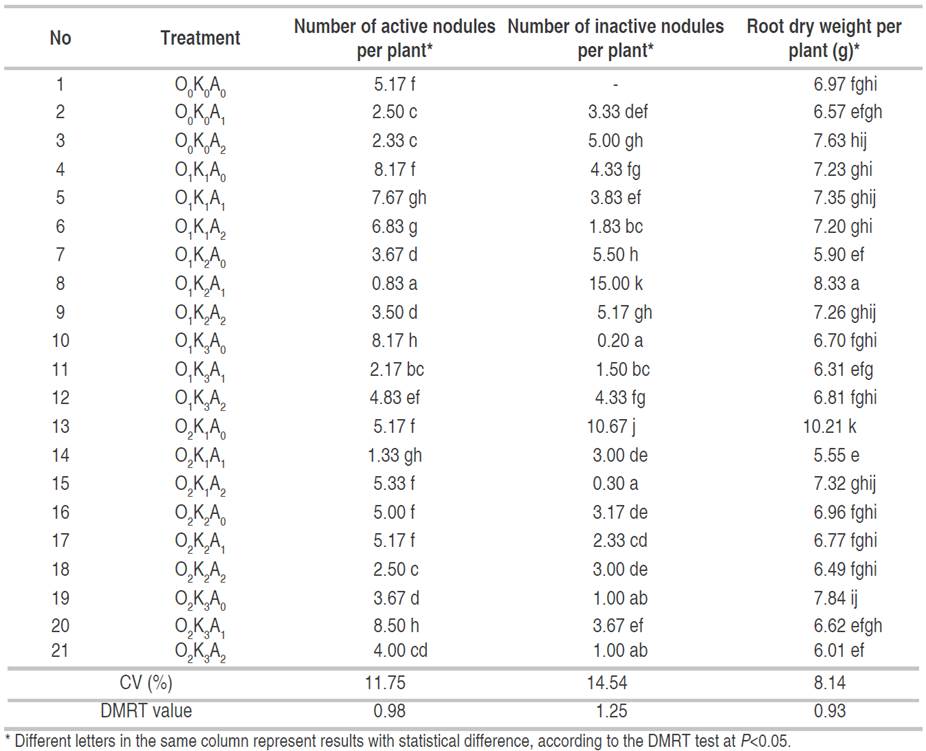
The highest dry weight of roots per plant (10.21 g) was found in treatment (O2K1A0), which used 1,000 kg ha-1 compost without urea fertilizer. In accordance with this result, it was confirmed that organic management has a significant impact in rhizobia genotype presentation in that area. Rhizobia numbers was increased in term of diversity in this kind of field, since organic fertilizer is a good medium for the development of the rhizobia genotype so that it has an effect on N-fixation from air (Grossman et al., 2011).
Soybean yield was determined by the development of the plant from the beginning of sowing to the harvest period, where the role of fertilization was of great importance. Application of different organic and chemical fertilizers would affect one or all of its yield components, namely: number of pods per plant, number of seeds per plant, weight of 100 dried seeds and yield of dried seeds. Number of pods per plant, number of seeds per plant, weight of 100 seeds and yield of dried seeds showed a significant difference during treatment using organic fertilizers and chemical fertilizers (Table 6).
Table 6 Effect of organic fertilizer on the number of pods, number of grains per plant, weight of 100 seeds and yield of soybean dried seeds in Rubaru District, Sumenep Regency, wet season 2018.
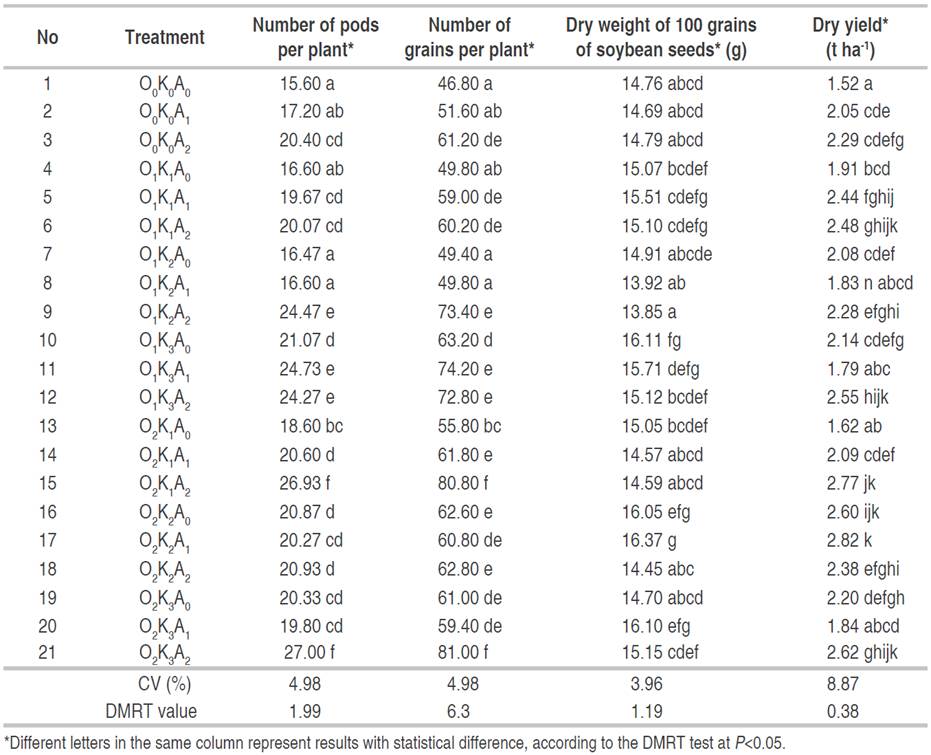
The highest number of pods per plant (26.93-27.00 pods) was found in treatments (O2K1A2 and O2K3A2) 1,000 kg ha-1 and 3,000 kg ha-1 compost + 100 kg of urea ha-1. Similarly, the largest number of seeds per plant was found in treatments 1,000kg ha-1 and treatment 3,000 kg ha-1 compost plus 100 kg of urea ha-1 (O2K1A2 and O2K3A2) with 80.80 seeds and 81.00 seeds, respectively.
The highest score in weight of 100 dried seeds was found in treatment 2,000 kg ha-1 compost + 50 kg of urea ha-1 (O2K2A1), but it did not differ significantly with treatment 2,000 kg ha-1 compost without urea (O2K2A0), or with in treatment 1,000 kg ha-1 compost and 3,000 kg ha-1 manure + urea 0-50 kg ha-1 (O1K1A1, O1K3A0, and O1K3A1) and in treatment 3,000 kg ha-1 compost decomposer with 50 kg urea ha-1 (O2K3A1).
Dry seed (water content 11%) yield found in treatment 2,000 kg ha-1 compost plus 50 kg of urea ha-1 (O2K2A1) was 2,820 kg ha-1, but it did not change manifestly from treatment 1,000 kg ha-1 compost + 100 kg of urea ha-1 (O2K1A2) and treatment 2,000 kg ha-1 compost without urea (O2K2A0) as well as treatment using 1,000 ha-1 compost and 3,000 kg ha-1 manure + 100 kg of urea ha-1 (O1K1A2 and O1K3A2).
Compost decomposer has been shown to be able to increase soybean crop. And interestingly, in this study, crop yield using treatment 2000 kg ha-1 organic fertilizer and 50 kg ha-1 chemical fertilizer combined with compost decomposer showed the highest results of all treatments considering the dry yield. As shown in laboratory analysis results, compost decomposer contained beneficial fungi and bacteria for plants (Table 3). Thus, microorganisms within the compost decomposer would be able to increase the positive effect of fertilizers. Inoculation of Bacillus sp and Trichoderma asperellum plays important role in supporting plant growth through phosphate solubilization process and auxin and hydrolytic enzymes synthesis (Moreira et al., 2021).
Other parameters observed in this study, such as number of pods and number of seeds per plant also correlated with production yield. In line with prior study, higher results in dry weight of 100 grain soybeans indicate larger grain size which would contribute to higher production yield (Soverda, 2009). This study also showed that the number of active nodules did not significantly affect the production yield and this was contrary to a previous study suggesting that total active nodules in soybean was closely related to the Rhizobium activities in the root to bind N and increase soybean growth and production yield (Birnadi, 2014). The root nodule was a very complex organ from the nodule formation itself and in the transport between membranes that occurs in it (Oldroyd and Downie, 2008; van Hameren et al., 2013). Although studies regarding root nodules have shown some progress, more studies were necessary to comprehend processes that occurred within this organ (Oldroyd and Dixon, 2014; Sulieman et al., 2014).
The highest productivity value (per hectare) was obtained using 1,000 kg ha-1 compost decomposer and 50 kg ha-1 chemical fertilizer followed by the treatment of 2,000 kg ha-1 combination of compost decomposer and organic fertilizers along with 50 kg ha-1 chemical fertilizer (Table 7). The relationship between productivity and cost (fertilizer) showed the highest results using 2,000 kg ha-1 combination of compost decomposer and organic fertilizers along with 50 kg ha-1 chemical fertilizer followed by 1,000 kg ha-1 compost decomposer and 50 kg ha-1 chemical fertilizer. Moreover, comparison concerning the amount of energy consumed between each system should be considered. A study conducted in the province of Jilin, China showed that production cost in conventional systems was 33% lower and its net income was 25% higher compared to organic systems (Zhang et al., 2015). Deficient energy use in organic farming is due to the use of fuel and plastic mulch, which result in a lower production yield (Lee and Choe, 2019).
Agricultural Analysis
Result of soybean analysis of this study was based on the increase of production cost after applying urea fertilization and organic fertilizer and also based on the seed yield as a result of fertilization treatment at the study site in Rubaru-Sumenep. Table 7 showed financial analysis of soybean at the study site.
A combination of 2,000 kg ha-1 compost and urea 50 kg ha-1 (O2K2A1) resulted an additional yield about 770 kg ha-1 compared to application of 50 kg urea only. Thus, farmers could obtain additional gross profit up to 411.88- or 333.43 USD ha-1 for net profit. This profit number could be obtained by O2K1A2 treatment.
CONCLUSIONS
Fertilization significantly increases the dry yield in comparison to the control treatment. This current study demonstrated the beneficial impact of chemical and organic fertilizer on promoting soybean yield. A mixture of chemical and organic fertilizers has higher result over the yield compared to the use of chemical fertilizer only. The application of 1,000-2,000 kg ha-1 compost with urea 50-100 kg ha-1 (O2K2A1 and O2K1A2) showed an increase in 35.12-37.56% seed yield with profit reaching USD 333-340 per hectare compared to standard treatment. These results suggest that combining chemical and organic fertilizers has the potential to sustain high grain yield mitigating the environmental impact caused by the overuse of chemical fertilizers.
Furthermore, 1-2 t of compost treatment is recommended particularly for soil with low organic content or soil that has never been planted with soybean. In the future, studies regarding the effect of organic fertilizers in soybean cultivation might be done using rice fields or inundated soils and also using soil with medium to high organic content. Besides, comprehensive farming analysis for production cost components including price of labor and pesticides should be done to obtain more accurate economic estimation.














